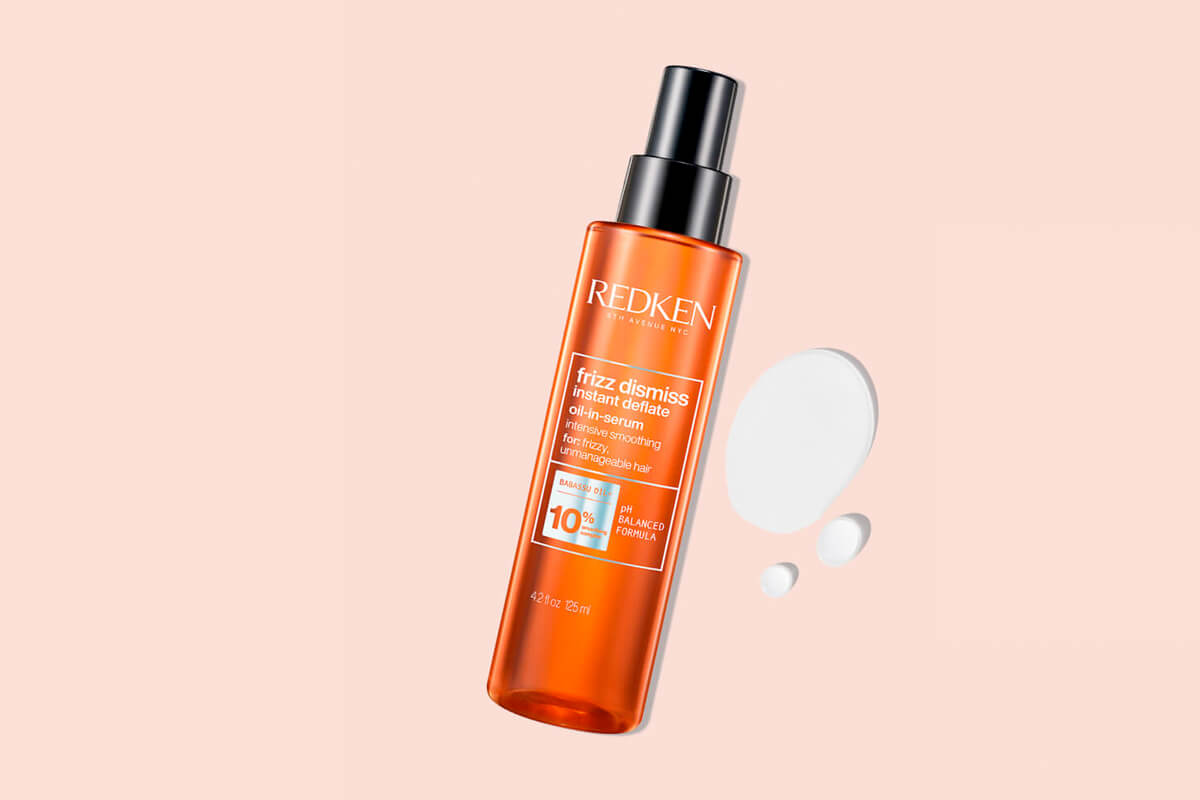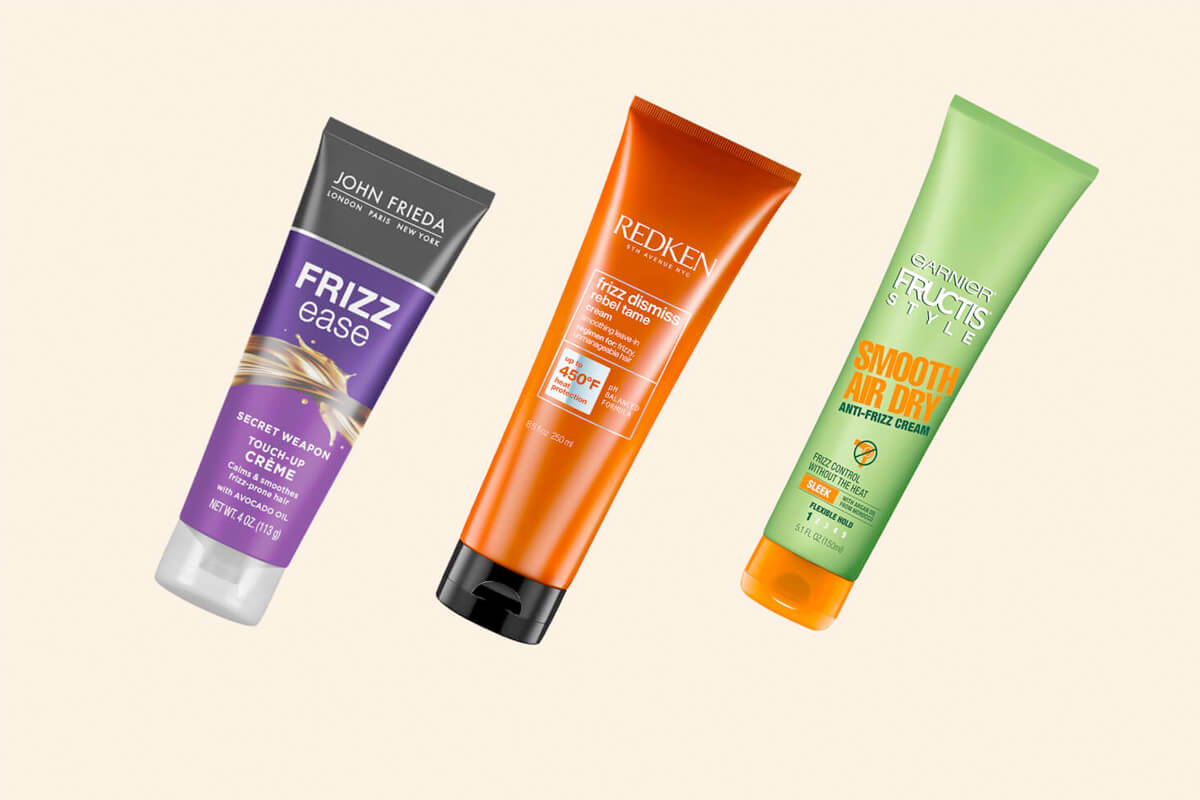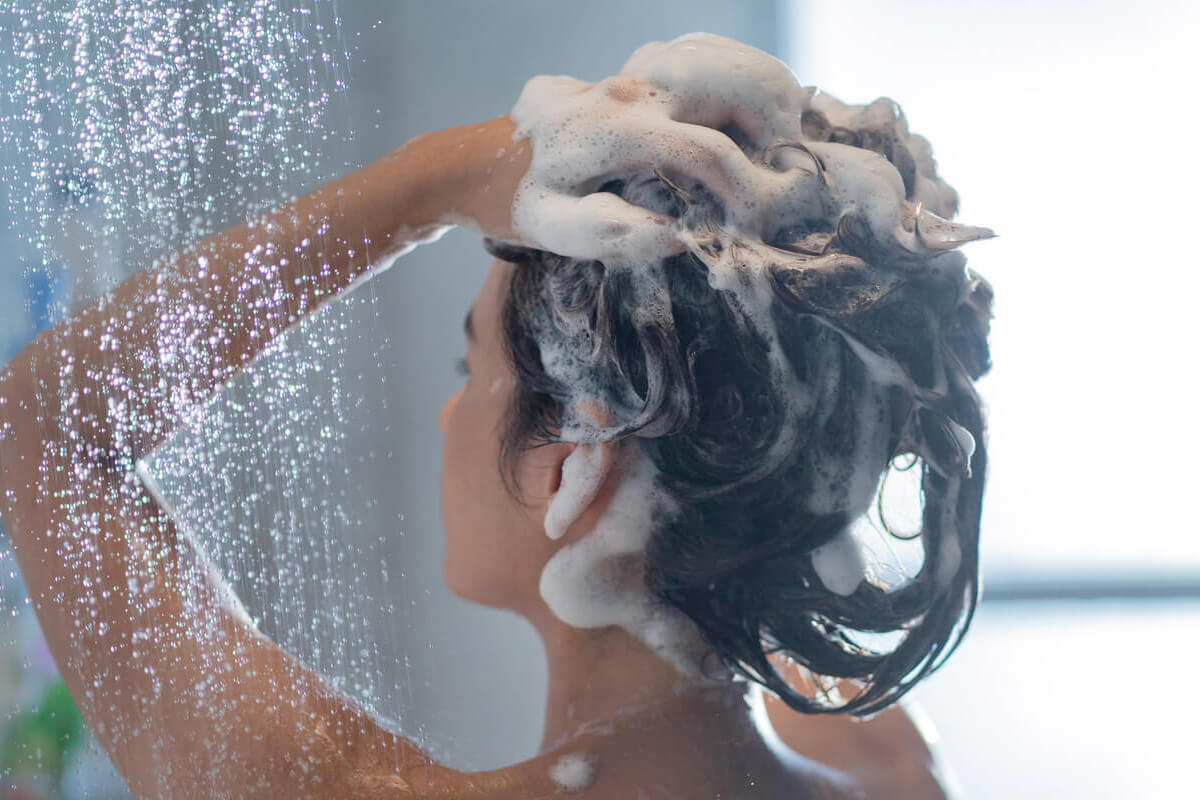What is Halo Frizz and the Best Ways to Tame It
Updated on
This post may contain affiliate links. As an Amazon Associate, we may earn from qualifying purchases.

Halo frizz, also known as the crown frizz or top layer frizz, is the appearance of unruly strands poking out and floating around patternless atop the main body of the hair, creating the illusion of a quasi-halo.
Also commonly described as a flurry of flyaways on top of the head, it makes the hair look messy, unkempt, and often challenging to style.
So how do you tame it and prevent it from putting a damper on your hairstyles?
Read on to learn more about the main causes and the best solutions we recommend.
Table of Contents
Description of Halo Frizz

Halo frizz can be easily identified by looking at a person’s hair from behind or with light reflecting on the head, emphasizing the top layer of disorganized, fluffy, and wispy hairs that don’t blend into the rest.
Types of Halo Frizz
Depending on your hair type and texture, a halo of frizz can also manifest in other different ways as described below:
1. The Frizzy Crown – Ring of Damaged Hair
A “frizzy crown” or the “crown effect” may sound angelic, but in reality, it’s a layer of damaged hair strands that have lost their shape, texture, and elasticity.
Unlike a healthy hair strand, a dry or damaged hair strand will stick out of the pile to seek moisture from its surrounding. Multiply that occurrence by a few dozens – it’s a frizzy mess!
2. The Top Fry – Dry Outer Layer Hair
Dryer hairs on the surface create layers that don’t weigh down enough to clump together with the body of the hair. They have a tendency to lift off the head doing their own things due to being lighter in weight.
3. The Curls From Heaven
Halo frizz in curly hair happens when the curls on the top layer are looser and frizzier than the curls closer to the roots. This causes an irregular curl pattern with a cheeky riot of ringlets rising above the uniform curls to create their own layer of “curls from heaven” halo effect.
4. The Wispy Static Conducting Hairs
This type of frizz is more like static hairs sticking out straight all the way. There is no bend or curl, no pattern, and no weight to help these strands blend into the body of the hair. This type of frizz happens due to new growth or breakage, creating shorter hairs that don’t have enough buoyancy, mass, and elasticity to mix with the mature hair strands.
5. The Fuzzy Halo
A fuzzy lil halo of frizz happens when the bottom layer of hair is thick, and the top layer is mostly fine strands due to a lack of trim. When frizz strikes, the combination of fine and thick hair creates the appearance of a fuzzy and irregular texture on the surface.
6. The Split End Flyaways Invasion
Not trimming your split ends regularly can lead to the broken ends taking over, causing the damaged inches to stick straight up from the top of the head. These damaged hair parts will continue to live the frizz life floating on top until they are trimmed.
7. The Parting Halo
No parting, no style, just a mop of nothingness. Frizzy hair sticking out around the partings can be due to new growth of hairs that are not long enough.
8. The Forehead Frizz-Halo
The forehead frizz happens when you have too many crazy baby hairs along your forehead that don’t stay put when your hair is pulled back. As a result, it blurs the forehead hairline.
What Causes Halo Frizz?
Halo frizz can be caused by various factors ranging from hair styling products to the way you style your hair. So before you try to fix it, it’s essential to pinpoint the main source of the problem.
Here are a few reasons why you may be experiencing frizziness on your crown:
Lack of Moisture
Dry hairs are moisture magnets. When the humidity is high, these hair strands will lift off the head to chase every last bit of moisture they can get from their surroundings.
Tight Pullback Hairstyles
When you pull your hair back into a ponytail, bun, or style that causes it to be tight against your head, you’re also putting tension on your hairline. This can cause the hairs on top to break unevenly, and stray away from the main pile of hair.
Product buildup
Excess product buildup on your scalp can weigh down your roots, leaving the outer hairs to stick up due to a lack of consistent volume and shape that would otherwise clump them all together smoothly.
Out of Control Split ends
Split ends happen when the sheath around the older parts of the hairs becomes too weak to hold on to their lengths. This causes the tips of the hairs to break off at different lengths, creating a mix of dry ends and uneven lengths that make the top layer of the hair look like a halo of flyaways.
Dry Roots
A rim of dry roots extending past your hair parting can cause the inner strands to stick out without volume, which eventually adds up, giving rise to a frizzy halo of hairs.
Brushing the Wrong Way
Brushing “against the grain” or brushing when your hair is dry can break up the clumps, stretching the hair out of shape and forcing shorter hairs to spring outwards. Always brush your hair when it’s wet and drenched with conditioner to prevent friction.
Too Much Heat
Applying too much heat to style your hair can cause it to frizz to the high heavens!
Remember: The ends of the hair are dryer. If you don’t use a good heat protectant when blow-drying or straightening, heat can frizzle your fragile ends, causing a “top fry” halo effect.Alcohol-Based Products
Most styling products contain alcohol to dry out fast and set a hairstyle in place. However, not all alcohols are good for the hair. Bad alcohols such as Denatured Alcohol, Alcohol Denat, Ethanol, Ethyl Alcohol, Propanol, Propyl Alcohol, and Isopropyl Alcohol can wick moisture from your strands, sucking them dry. If you use styling products with such ingredients regularly, they will eventually cause dry, dehydrated, and brittle hairs that eventually amplify the appearance of frizz.
Friction from styling
Friction from combing, brushing, and blow drying can create static charges on the hair, causing the strands to repel each other and rise up off the scalp rather than lay flat.
Wrong HairCut
A bad haircut can affect the way your hair falls because it might not consider the texture of your strands. Short curly hair (or any other texture) can go straight if not cut properly. In this case, a “bad” haircut would result in shorter, wispy-looking ends, which could contribute to the appearance of frizz depending on how you style it or whether or not there’s weight applied from cutting off too much.
Once again, the type of cut will play a major factor in longer hair. A blunt cut might cause frizzy-looking ends because your naturally wavy locks won’t fall as naturally anymore, and your curls may look stringy or damaged due to increasingly being forced to fight against gravity where they don’t want to.
The Natural Process of Hair Shedding
Hairs that have peaked their growth cycles will eventually shed, making space for new hairs to sprout in their places. Compared to existing hairs that have matured and have enough length and mass to hold their own, new growths will take a few weeks to mature and grow enough length to hold their own. In the meantime, they just live as frizz and do their own things independently, like sticking up straight.
How to Tame Halo Frizz
A frizzy halo concentrates around the crown of the head and sometimes along the hairline or on the forehead, making it easy to target and pat down with anti-frizz styling products.
Here are a few solutions that can help to instantly deflate a crown of frizz:
Anti-Frizz Hair Sheet

These small purse-portable sheets let you tame crown and forehead frizz instantly by swiping down the wild and wispy strands that refuse to lay flat. Perfect for dry and static prone hair, anti-frizz sheets are excellent for frizz that develop on the top layer when the humidity is high.
Formulated with anti-static and fast-acting moisturizing ingredients, they are super convenient to quickly defrizz your locks on the go.
Recommended: The best anti-frizz hair sheets
Anti-Frizz Hair Serum

A hair serum is an excellent non-greasy lightweight styling product that can instantly deflate frizz and flyaways on the crown and the back of your head by coating the individual hair strands with silicone agents.
Besides taming frizz, it also seals split ends to help them bunch up uniformly with the rest of the hair.
Recommended: Redken Frizz Dismiss Instant Deflate Serum.
Anti-Frizz Cream

A hair smoothing cream helps second-day or unwashed hair from unraveling into frizz. With intense smoothing ingredients, humidity protection, and texture-enhancing benefits, you can count on this excellent leave-in treatment to hold your hairstyle in place without a single strand out of place.
Recommended: Best anti frizz hair creams.Hair Styling Mousse

A hair styling mousse improves curl texture and definition by ensuring your curls clump together nicely.
It helps emphasize a more uniform curl pattern when your curls look like they are having a texture crisis.
Perfect for curlies who want flexible hold hairstyles with good definition without the limp curls on the top layer wilting into a halo of frizz.
Hair Gel

A hair gel is excellent for taming wispy baby hairs along the forehead to keep your hairline under control. With more stronghold than a cream or mousse, it’s best used for edge control or slicked-back hairstyles.
Quick fixes are great but bear in mind, they don’t necessarily address the source of the problems. So let’s have a look at how you can address the problems from the source by embracing a hair care routine that can eliminate any type of frizz for more long-lasting easy to manage hair.
How to Prevent and Get Rid of Halo Frizz
Here are a few changes you can make to your hair care routine to prevent frizz, reduce split ends, and prevent breakage, which can all contribute to reducing and eliminating frizz on the crown of your head.
Deep Cleanse Your Hair Regularly

One of the factors that can affect the effectiveness of your hair conditioner or moisturizer is product buildup. Oils, serums, silicone, and waxes from styling products can cling to the hair shafts over time, creating a layer that blocks out moisture and nutrients from your favorite hair products.
This is why your hair always feels dry no matter how much conditioner or hair mask you use.
To fix this problem, give your hair a deep cleanse. Add a clarifying shampoo to your hair care routine – once a week or once every 2 weeks is enough to give your strands a proper purge and a total reset.
Recommended: The best clarifying shampoos for hair and scalp.
Use a Good Anti-Frizz Conditioner

If you want to eliminate frizz, the process starts in the shower.
Always follow up your shampoo with a good anti-frizz conditioner. Besides making your hair feel smooth and shiny, a conditioner neutralizes the negative charges left by shampoos on the hair. It also lowers the hair’s pH to flatten the cuticles, making your locks easier to detangle with a wide-tooth comb or brush without creating friction.
Use a Microfiber Towel

Microfiber towels reduce frizz in hair by soaking up water without the need to rub, which reduces friction. The fabric is designed to be gentle compared to coarse cotton fabrics that can ruffle the hair’s cuticle layer.
Additionally, a microfiber towel enables hair strands to cling together into clumps, which helps enormously to reduce frizz after washing.
Avoid Tight Hairstyles

Try not to pull your hair back too tightly. The tug and pull from tight hairstyles put tension on your hairline, causing hairs to break at uneven lengths. That’s why some stay put, and some stick out because they don’t have enough length to clump together.
If you think your crown frizz is related to tight hairstyles, take a break from them and wear your hair loose for a while to avoid putting stress on your locks.
OR use a serum or oil on your hairline before pulling your hair back. This will help lubricate and protect the hair from breaking.
Try the Curly Girl Method

The curly girl method is a way of caring for curly hair that involves using specific products and techniques to reduce frizz.
By zeroing down on harsh chemicals and incorporating clean products that don’t strip natural oils from the hair, the Curly Girl Method helps your curls rediscover their spring factor with enhanced definition and pattern.
Here are some of the ways it can help reduce frizz:
- Co wash (conditioner only washing) – It won’t strip the hair’s natural oils
- No Silicone products – No buildup
- No alcohol-based products – Hair doesn’t dry out when styling
Trim Your Split Ends Regularly

Don’t let your split ends take over.
Trimming the damaged parts of your hair regularly minimizes the appearance of uneven layers, and straggly hair ends sticking up randomly.
Banish Halo Frizz
The aura of frizz around the head can look treacherous at times, but it’s still more manageable than other types of frizz. Simple styling tweaks like moisturizing touch-ups, brushing the hair the right way, frequent trims, and getting the right haircut can help keep halo frizz under control and make your hairstyles look sharp and sleek.
Time to stop photoshopping them out of your selfies and embrace a holistic hair care routine that eliminates frizz from its source.
About the Author
 Tina Moretti
Tina MorettiTina Moretti, a passionate hair care enthusiast with over a decade of expertise, dedicates herself to empowering women with proven hair care advice. Recognized for her hands-on experience and trusted guidance, Tina turns every strand into a statement of beauty and confidence.